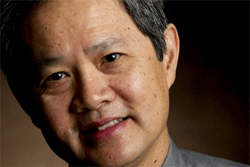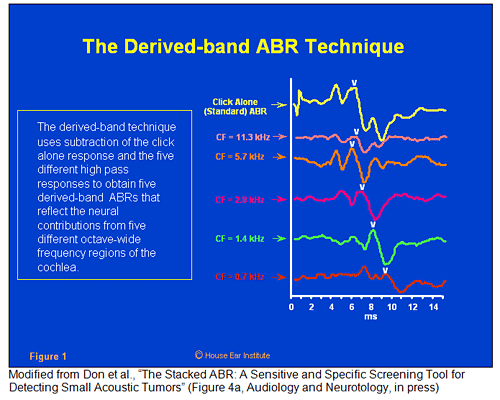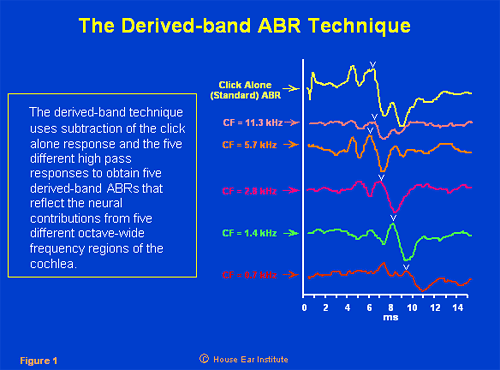Interview with Manuel Don Ph.D., Electrophysiology Department Head, House Ear Institute, Los Angeles, California
Topic: Stacked ABR
 Beck: Hi Manny. It is a pleasure to speak with you again. It's been almost 20 years since we worked together at the House Ear Institute.
Beck: Hi Manny. It is a pleasure to speak with you again. It's been almost 20 years since we worked together at the House Ear Institute.Don: Hey Doug. Nice to speak with you too. I guess we're starting to get old!
Beck: Starting? Manny, if you don't mind, let's start with a little bit of your educational history, and then we'll get to the topic of Stacked ABRs.
Don: Sure thing. I was raised in Arizona, and earned my undergraduate degree at the University of California at Berkeley, where I was actually a speech major. I came back to the University of Arizona to pursue my graduate education in speech. Dr. Paul Skinner (a faculty member of the Speech and Hearing Sciences department) saw that I had extensive science background and he pretty much recruited me into the hearing sciences program. So I earned my master's degree there and then went to Stanford from 1966 to 1971 and earned my Ph.D. in Hearing Sciences in 1971, under the mentorship of Dr. Earl Schubert. I stayed at Stanford for a 2-year post-doctoral fellowship. After that, I took a position at University of California at Irvine and worked with Dr. Robert Kohut (Otolaryngology) and Dr. Arnold Starr (Neurology).
Beck: And your master's thesis and your dissertation were both on electrophysiology weren't they?
Don: Yes. My master's thesis (1967) was based on cortical evoked potentials in humans, and my dissertation was based on recordings from the medial geniculate of squirrel monkeys. We also looked at behavioral issues like lateralization tasks to see how that relates to electrophysiologic measures. I've always been very interested in behavioral work combined with electrophysiology.
Beck: When did you start at the House Ear Institute?
Don: Well, that's a long story too....Back in the mid-1970s, Dr. Derald Brackmann, one of the senior neurotologists at the House Ear Clinic, had started doing cochlear implants. Of course, that was way before the FDA approval some ten years later...but he was investigating the technology in the mid-70s using the UTAH device. Dr Brackmann wanted a way to record electric ABR (EABR) because he saw the value in gathering that information on cochlear implant patients. At that time, I was working with Dr. Starr (who was my thesis supervisor at Stanford) through my position with him at the University of California at Irvine (UCI). They wanted to use my ABR program to do EABRs on an implanted patient, so I went in on a Saturday to work with them. Based on that work, Drs. Arnold Starr and Derald Brackmann published the first paper on EABRs in the mid-1970s, and that's how I met Dr. Brackmann. Shortly after that, Dr. Brackmann wanted to open an electrophysiology lab at the House Ear Institute and I was recruited in 1976, some 28 years ago! One of our first studies was to investigate the use of ABRs and ECoG in the detection of acoustic tumors.
Beck: Manny, although I would totally love addressing ECoG and ABR as independent topics, we'd better save that for another day! Please define the term "Stacked ABR" for me, and if you would, can you give me an introductory discussion on ABR as it relates to tumor detection?
Don: A Stacked ABR is basically an attempt to record the sum of the neural activity across the entire frequency region of the cochlea in response to click stimulation.
The idea goes back to the fact that when we first started to record ABRs in tumor patients in the mid-1970s, we were very interested in looking at ECoG and ABR in tumor patients, to see if we could detect tumors using our electrophysiologic tools.
In general, we found that when tumors were large, we could detect them via ABR tests. But, for smaller tumors (
The most common ABR measure for tumor detection determines if the latency of wave V in the suspect ear is abnormally longer than the latency from the presumed healthy, contralateral ear (called the interaural wave V delay). However, because the latency of wave V is dominated by neural activity from the fastest and highest frequency fibers that respond to a click stimulus, the latency can increase only if these high frequency fibers no longer dominate the response -- or are prolonged due to the tumor. When the high frequency fibers no longer dominate the response, the latency increases because the activity becomes dominated by the lower frequency fibers, which respond slower, due to the traveling wave delay producing a longer latency.
Similarly, when you have high frequency hearing loss, ABR latencies increase because of the loss of domination of the high-frequency fiber activity. If the high frequency fibers still dominate, then the tumor must cause a prolongation of their latencies. In either case, the high-frequency fibers have to be affected in order for the latencies to increase.
And so, if you have a small tumor, and if it is not impacting the responses from the high frequency fibers sufficiently, the standard ABR latency measure will be normal, thereby "missing" the tumor. Now of course, there are exceptions, and one very important concern for tumor detection with ABRs is the location of the tumor.


Modified from Don et al., "The Stacked ABR: A Sensitive and Specific Screening Tool for Detecting Small Acoustic Tumors" (Figure 4a, Audiology and Neurotology, in press)
Beck: So even a tiny tumor, if it's impinging upon the auditory nerve, blocking conduction, delaying conduction or causing some sort of auditory nerve dys-synchrony, will have a much higher chance of being detected via standard ABR than the same size tumor which may not be in physical contact with the cochlear nerve?
Don: That's right. But it can be missed if it doesn't affect the high-frequency fibers. So we developed an ABR measure that doesn't only depend on the tumor affecting the high frequency fibers, but one that is sensitive to the effect of the tumor on any fibers. Using a high-pass masking technique, we divide the cochlea into octave bands and obtain ABRs from each octave band (Figure 1). These are called derived-band ABRs. We then add these derived-band responses together - and that's the "stacking part." But to do that, we first had to time shift them, so all the wave V peak latencies of these octave band responses lined up. Because the responses represent activity from different frequency regions, the latencies will be longer for the lower frequencies regions. Much of the activity from the lower frequency regions of the cochlea is not seen in the standard ABR due to phase cancellation of their activity by higher frequency regions. By shifting and aligning the activity from the various parts of the cochlea, we eliminate the phase cancellation so that all parts of the cochlea contribute synchronously to the sum of the derived-band responses. The sum of these shifted and aligned derived-band waveforms is called the Stacked ABR (Figure 2). Thus, the wave V amplitude of the Stacked ABR is composed of synchronous activity across the whole cochlea. This amplitude typically is a very large response whose amplitude is very similar to the EABR obtained with a single channel cochlear implant, as such an implant will stimulate all of the nerve fibers synchronously. And so, if the tumor is in contact with and desynchronizes or blocks activity from any part of the auditory nerve, it will reduce the amplitude of the Stacked ABR.
Beck: And so the Stacked ABR is more sensitive to the presence of tiny acoustic neuromas than standard ABR?
Don: Yes, that's exactly right. In a new paper that will be published in the journal "Audiology and Neuro-Otology," we examined 54 smaller tumors and compared Stacked ABR measures to standard ABR measures. Our stated criteria for success with the Stacked ABR, was to achieve 95 percent sensitivity, with 50 percent specificity. We thought that if we could save some people from getting MRIs that would be useful. We achieved the goal, and in fact, surpassed it.
Beck: OK, I am convinced that the Stacked ABR is more sensitive than standard ABR in detecting tumors, even the really small ones. However, in 2005, how likely is it that anyone will order a Stacked ABR if they have a high, or perhaps even a low, index of suspicion for an acoustic tumor? Seems to me, with all due respect, that the patient is going to get an MRI anyway....or am I missing something?
Don: Well, that is a key issue. If there is a reasonable index of suspicion, the physician is almost forced to order an MRI for a patient, and that's fine. However, in some rural communities, and other locations too, there are places where MRI is not available, or the cost is prohibitive, or the patient is not able to undergo a radiologic exam for whatever reason, and that's where this technology is very useful. Of course an important consideration is that in many parts of the world, MRI is much less common than it is in the USA, and so in many locations, the Stacked ABR may serve as a screening tool for tumors, in the absence of, or with poor accessibility to, MRI exams.
Beck: I understand. And is this software available commercially?
Don: Yes. Bio-logic Systems Corp., with the help of an NIH SBIR grant, has implemented the technology. Readers can contact Bio-logic to obtain more information on this technology. Stacked ABR is a tool that allows us to gather more information based on electrophysiologically ascertained measures. And the way to go about this would be to start with a standard ABR. If the standard ABR is positive, there's no need to do a Stacked ABR, the clinician would order and obtain an MRI. However, if the standard ABR is normal, and yet the index of suspicion is still an issue, that's when you go to the Stacked ABR. We know the Stacked ABR has a sensitivity of 95 percent...so if that's normal too...you may want to wait and watch. If the Stacked ABR is positive, you probably have compelling evidence to order an MRI.
Beck: Manny, this is really amazing technology. Thanks for explaining this to me. I know you just gave me the tremendously abbreviated version, but I am very appreciative of your time and knowledge, and thanks for the explanation. It makes a lot of intuitive sense.
Don: My pleasure Doug. Happy to help.
--------------------
For more information, Dr. Don can be contacted at the House Ear Institute at (213) 483-4431. Also, visit the House Ear Institute website.

